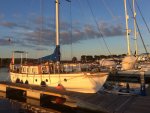LittleSister
Well-known member
Thanks L.S., they still make a very persuasive case all round.
Have you any idea what proportion of LM 27s had the bilge plates, enabling drying out upright on hard surfaces?
Not many, I would think. I think the bilge plates would have been fitted to LM24s and LM27s either to order by the UK importer, Scanyacht, or by subsequent owners. (Scanyacht also bought the moulds after LM ceased production of the LM27 and built a de-luxe version (with options of deeper keel/taller rig and different internal layouts) called the Scanyacht 290.)
The later series LM motor-sailers - LM26, LM28, LM30 & LM32 - were mainly fin keel, but some were (factory fitted) twin bilge keels. There seem to be fewer of those in the UK and they tend to be more expensive than the 24s and 27s. (LM also built non-wheelhouse fin keel yachts, but I think there are very few, if any, in the UK.)




